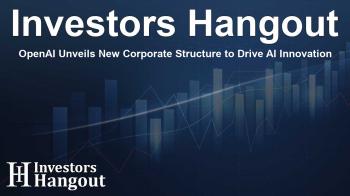OpenAI Unveils New Corporate Structure to Drive AI Innovation

OpenAI's Strategic Shift Towards a Public Benefit Corporation
OpenAI has taken a significant step in reshaping its corporate identity to better secure the funding necessary for its ambitious goals in artificial intelligence (AI). The company recently announced plans to transition its existing for-profit arm into a public benefit corporation (PBC). This strategic move aims to attract more capital while still considering the interests of society alongside shareholder value.
Understanding the Implications of the New Structure
The evolution of OpenAI's structure reflects both the challenges of the fast-paced tech landscape and the growing need for substantial funding in the AI sector. By forming a PBC, OpenAI aims to operate under a framework that not only facilitates larger investments but also aligns its operational goals with social responsibility. This approach marks a departure from the traditional profit-centric corporate model and allows OpenAI to potentially serve both its investors and the public good.
Investments and Funding Rounds
The decision to pursue a PBC comes in light of OpenAI's substantial funding rounds, including a recent noteworthy $6.6 billion investment that valued the company at $157 billion. This funding was contingent on the restructured corporate model, emphasizing the critical role that such changes play in attracting investors.
With the growing competition in the AI domain, OpenAI's new structure aims to position the company alongside peers like Anthropic and xAI, which have successfully utilized similar corporate forms to raise significant capital. For instance, Anthropic recently received a $4 billion boost from Amazon, demonstrating the attractiveness of the PBC model in drawing substantial investments.
Balancing Profit with Mission-Driven Goals
As OpenAI transitions to this new structure, it will have to navigate the complexities associated with balancing profit-making objectives with its mission of developing safe and beneficial AI. The return of former CEO Sam Altman highlighted the ongoing challenges within the organization, as the leadership works to align its goals with those of its stakeholders while managing public scrutiny.
This balance is critical, as investors and the community will be closely watching how well OpenAI integrates its profit-seeking activities with the inherent responsibilities that come with being a benefit corporation. Although the legal framework allows for some flexibility, it ultimately places the burden on shareholders to define how clearly the company adheres to its mission.
Controversies and Challenges Ahead
Despite the strategic intentions behind OpenAI's restructuring, challenges remain. Co-founder Elon Musk has emerged as a vocal critic, pursuing legal action to challenge the planned transition. His concerns are centered around the fear that profit motives may overshadow OpenAI's commitment to the public good. Musk's criticism and ongoing legal battles could complicate OpenAI's path forward as it navigates this intricate landscape.
Other tech advocates, including Meta Platforms, have also voiced their resistance to the transition, with calls for regulatory oversight concerning OpenAI's shift to a for-profit model. The outcome of these conflicts could significantly influence OpenAI's operational landscape as it attempts to fulfill its commitments while appeasing stakeholders on multiple fronts.
Looking Forward: The Future of AI Development
As OpenAI continues to redefine its role in the AI race, the market landscape remains optimistic yet cautious. With major tech companies investing heavily in AI, the pressure to innovate and lead in this space has never been higher. OpenAI's shift to a public benefit corporation is its attempt to ensure sustainability and progressive growth in an era where AI technology is rapidly evolving.
The company’s new direction reflects an understanding that to remain competitive and mission-driven, adjustments to its corporate structure and funding approaches are necessary. Whether OpenAI can successfully balance these interests will be paramount in determining its future as a leader in artificial intelligence development.
Frequently Asked Questions
Why has OpenAI decided to become a public benefit corporation?
OpenAI aims to attract more capital and align itself with social responsibilities while pursuing its ambitious AI goals.
What are the main advantages of OpenAI's new structure?
The public benefit corporation model allows for greater investment opportunities while balancing societal interests with profit-making objectives.
How does this change affect OpenAI's investors?
Investors may find the new structure appealing as it could enable larger funding rounds while committing to responsible corporate governance.
Who are OpenAI's main competitors in this new landscape?
Competitors include Anthropic and xAI, both of which have successfully utilized similar models to secure significant funding.
What challenges does OpenAI face in this transition?
OpenAI must navigate legal challenges from Musk and ensure a successful balance between profit and its mission in order to gain public trust.
About Investors Hangout
Investors Hangout is a leading online stock forum for financial discussion and learning, offering a wide range of free tools and resources. It draws in traders of all levels, who exchange market knowledge, investigate trading tactics, and keep an eye on industry developments in real time. Featuring financial articles, stock message boards, quotes, charts, company profiles, and live news updates. Through cooperative learning and a wealth of informational resources, it helps users from novices creating their first portfolios to experts honing their techniques. Join Investors Hangout today: https://investorshangout.com/
Disclaimer: The content of this article is solely for general informational purposes only; it does not represent legal, financial, or investment advice. Investors Hangout does not offer financial advice; the author is not a licensed financial advisor. Consult a qualified advisor before making any financial or investment decisions based on this article. The author's interpretation of publicly available data shapes the opinions presented here; as a result, they should not be taken as advice to purchase, sell, or hold any securities mentioned or any other investments. The author does not guarantee the accuracy, completeness, or timeliness of any material, providing it "as is." Information and market conditions may change; past performance is not indicative of future outcomes. If any of the material offered here is inaccurate, please contact us for corrections.
